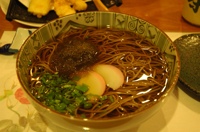I have a superb Japanese cookbook, Japanese Homestyle Cooking by Suzuki Tokiko-san. I have a bit of a love-hate relationship with it. Love, because it’s a great book with many delicious and interesting recipes. Hate, because most of those recipes require what seems like days of effort to make properly, and Suzuki-san is very insistent on proper procedure. “The rice must be washed eighty-seven times, until the rinse-water is absolutely clear.” “Scrub the burdock root using a brush made only from the shinbone of a cow. The cow must be one that weighed no less than 550 kilograms, and no more than 650 kilograms. This is critical. If the shinbone is unbalanced, the dish will be an abject failure, and you will shame your family.”
OK, I admit it. Suzuki-san doesn’t actually say those things. But as I read her book, I feel like she’s saying them. Because at the end of the day, I find the recipes to be too much work. I want them to be quicker. Easier. More convenient. I need recipes more suited to my swinging, space-age-a-go-go lifestyle. Something from a cartoon: open the packet, pour the water on to the powder, and poof! There is a cloud of orange smoke, and as it dissipates I find a full meal, beautifully presented.
In other words, I am a barbarian, because it turns out that I am willing to settle for food that is only half as good as it could be if that means I only have to do one-tenth the amount of work. (At least when I’m the one doing the work. If you’re doing the cooking, I require nothing short of perfection.)
With that in mind, here is how to make soba noodles if you don’t care a whit about authenticity. This is soba for barbarians.
Unfortunately, not every dish can be made with a side of beef, one carrot, and a magnum of cheap red wine. So you’ll need to get some ingredients from your local asian store for this dish:
- One package soba noodles.
- 2 packets of dried bonito flakes.
- One package dried wakame seaweed
- Soy sauce
So the overall strategy here is to make something that vaguely approximates dashi, and then add soy sauce and noodles. Then, we will eat it.
To make a true dashi, of course, you’d need to follow a careful and precise process, and use konbu instead of wakame. But konbu is a pain in the ass, and you can’t really eat it without a lot more effort, and I like actually eating the seaweed, and I’m too lazy to spend the time to make a real dashi today. So instead we’re going to make mock-dashi.
Fill a large bowl with hot water and start soaking the wakame; when it has soaked for about 10 or 15 minutes, pour the water down the drain and set the seaweed aside. In the meantime, put a medium saucepan of water on the stove and heat. Take some bonito flakes (I use two 5 gram packets) and put them in a tea strainer (or cheesecloth, if you’re all fancy that way). When the water is boiling, turn off the heat, and when it stops boiling put the tea strainer into the water. Let that sit for 5 to 10 minutes. Take the tea strainer out and throw away the bonito flakes. Add soy sauce until it looks, smells, and tastes about right (it should have a pronounced but not overwhelming soy taste.) Bring the pot back to a boil. When it’s boiling, put in the soba noodles and stir; they should cook for about 5 minutes. Don’t overcook them. You can put the wakame in at any time after it’s back at a boil; the earlier you put it in, the more flavor it will give. Personally, I just throw the seaweed into the pot at the same time as the noodles, because that’s the laziest thing to do.
When the noodles are done, take it off the heat and serve immediately. It will taste great, and will get better in the fridge over the next couple of days.






Yes; I have that problem incessantly with Indian cooking – if I don’t take three hours with 6 servants, I’ve somehow failed to make the dish in the proper fashion and demonstrated once again that I am an uncultured barbarian.
Although is won’t be out until October, you might like my friend Elizabeth Andoh’s new cookbook, Washoku – Recipes from the Japanese Kitchen. It was tested in American kitchens with a wide range of participants and I think it’s well-suited to a modern, busy household. It’s published by Ten Speed Press. Elizabeth absolutely knows her stuff, having graduated from a Japanese culinary institute in the 60s and living in Japan for nearly 40 years. She writes for Gourmet magazine and the NY Times, too.